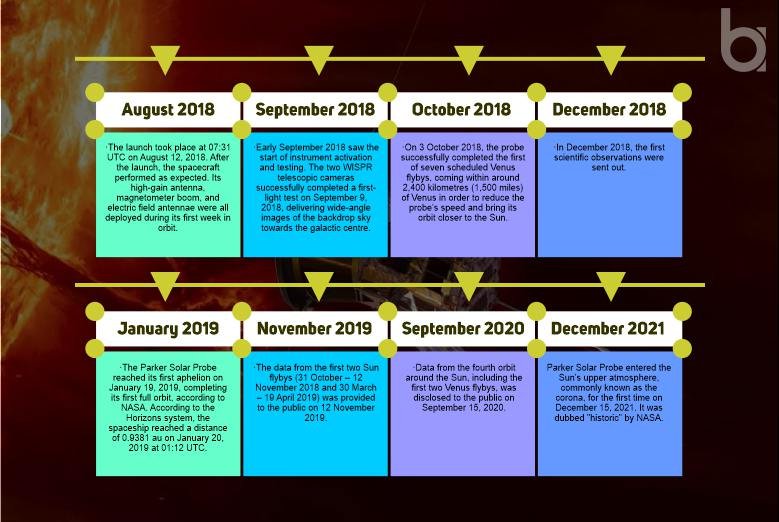The Parker Solar Probe has finally made it to the sun’s atmosphere. The NASA spacecraft spent more than three years weaving its way through planets and progressively approaching the Sun in order to learn more about the solar wind, which propels charged particles across the solar system.
As solar activity has a big impact on the life on Earth, from causing auroras to endangering infrastructure such as satellites, scientists want to learn more about how the sun works so they can better predict space weather.
When did the Parker idea surface?
The Parker Solar Probe (abbreviated PSP; formerly Solar Probe, Solar Probe Plus, or Solar Probe+) is a NASA space probe that was launched in 2018 with the goal of studying the Sun’s outer corona. It is expected to approach the Sun’s centre at a distance of 9.86 solar radii (6.9 million km or 4.3 million miles) by 2025, and will travel at a speed of 690,000 km/h (430,000 mph), or 0.064 percent the speed of light.
The project was announced during the fiscal year 2009. It will cost US$1.5 billion. The spacecraft was conceived and built by the Johns Hopkins University Applied Physics Laboratory and launched on August 12, 2018. It was the first NASA spacecraft to be named after a living person, nonagenarian physicist Eugene Newman Parker, emeritus professor at the University of Chicago.
Working Principle of the Mission
A solar shield protects the spacecraft’s systems from the Sun’s tremendous heat and radiation. At perihelion, incident solar energy is around 650 kW/m2, or 475 times that of Earth orbit. The solar shield is hexagonal in shape, mounted on the spacecraft’s Sun-facing side, and is made of reinforced carbon–carbon composite designed to withstand temperatures of about 1,370 °C (2,500 °F) outside the spacecraft. Absorption is reduced by a white reflective alumina surface layer. The spacecraft systems and scientific instruments are positioned in the shield’s shadow’s core part.
The Parker Solar Probe will have to operate autonomously and quickly to safeguard itself as radio communication with Earth will take roughly eight minutes in each way. The mission’s principal source of electricity is a twin system of solar panels (photovoltaic arrays). During the close approach to the Sun, the major photovoltaic array, is withdrawn behind the shadow shield, and the spacecraft is powered by a considerably smaller secondary array. The solar panels and equipment in this secondary array are kept at operational temperature using pumped-fluid cooling.
Findings of the PSP till date
The first four scientific articles presenting discoveries from the spacecraft were published on December 4, 2019. They reported on the Sun’s magnetic field’s direction and strength, as well as the abnormally frequent and short-lived fluctuations in the field’s direction. They also stated that they were able to observe “reversals in the Sun’s magnetic field are often associated with localized enhancements in the radial component of the plasma velocity” using the “beam of electrons that stream along the magnetic field.” Due to the vaporisation of cosmic dust particles by the Sun’s radiation, Parker discovered evidence of a cosmic dust-free zone 3.5 million miles (5.6 million kilometres) from the Sun.
The Timeline:

- August 2018: The launch took place at 07:31 UTC on August 12, 2018. After the launch, the spacecraft performed as expected. Its high-gain antenna, magnetometer boom, and electric field antennae were all deployed during its first week in orbit.
- September 2018: Early September 2018 saw the start of instrument activation and testing. The two WISPR telescopic cameras successfully completed a first-light test on September 9, 2018, delivering wide-angle images of the backdrop sky towards the galactic centre.
- October 2018: On 3 October 2018, the probe successfully completed the first of seven scheduled Venus flybys, coming within around 2,400 kilometres (1,500 miles) of Venus in order to reduce the probe’s speed and bring its orbit closer to the Sun.
- December 2018: In December 2018, the first scientific observations were sent out.
- January 2019: The Parker Solar Probe reached its first aphelion on January 19, 2019, completing its first full orbit, according to NASA. According to the Horizons system, the spaceship reached a distance of 0.9381 au on January 20, 2019 at 01:12 UTC.
- November 2019: The data from the first two Sun flybys (31 October – 12 November 2018 and 30 March – 19 April 2019) was provided to the public on 12 November 2019.
- September 2020: Data from the fourth orbit around the Sun, including the first two Venus flybys, was disclosed to the public on September 15, 2020.
- December 2021: Parker Solar Probe entered the Sun’s upper atmosphere, commonly known as the corona, for the first time on December 15, 2021. It was dubbed “historic” by NASA.
Read more: Outer Space discoveries and new space expeditions




















